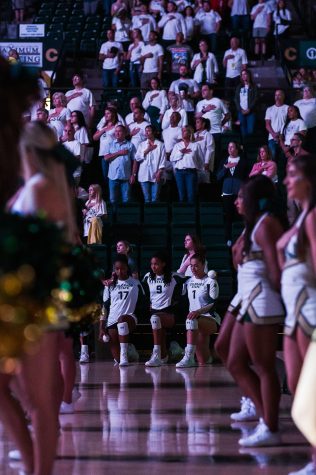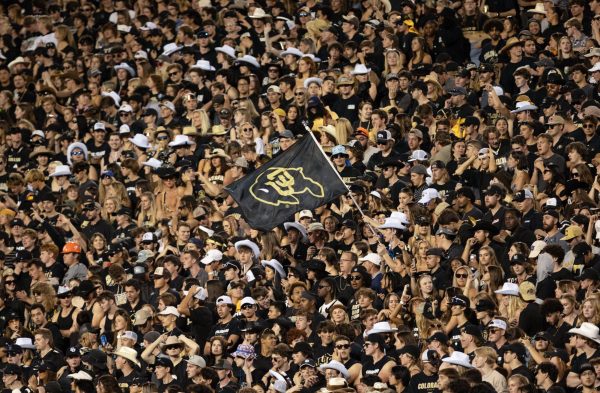CSU volleyball: Taking a knee for a cause beyond the game
September 22, 2022
In a symbolic act of resistance to racism, one kneels instead of standing during the performance of the national anthem or at other appropriate moments.
This movement originated when Colin Kaepernick, soon joined by then-San Francisco 49ers teammate Eric Reid, kneeled during the playing of the national anthem before a football game in 2016. Since that time, leagues, professional teams and well-known athletes all around the country have taken the initiative to kneel in support of a much larger message, including three volleyball players from Colorado State University.
Kennedy Stanford, Malaya Jones and Naeemah Weathers first began taking a knee back in 2020 during the COVID-19 pandemic, mass civil rights movements and the death of George Floyd.
Floyd’s murder solidified a new generation of players as protesters of police brutality and at the very least made professional sports leagues performative supporters. The history of athlete activism serves as a reminder that this movement has dramatic potential and the Rams recognized their actions deserve to be brought to light.

Taking a knee not only brings awareness to inequalities in this country but also quite a bit of controversy. Common misconceptions include kneeling often being portrayed as a sign of disrespect to the country and its troops, that it’s ineffective and that it causes even more division among people. Despite these misconceptions, taking a knee is a pro-rights movement that exercises the rights of the First Amendment, like freedom of speech.
“In sports, we kneel when someone is injured. It’s a sign of respect, truly, and if it’s us showing alternative respect during the national anthem, it shouldn’t be looked at as something bad.” –Kennedy Stanford, CSU junior outside hitter
“For us two (Stanford and Weathers), we both have parents who are former military,” Stanford said. “We understand it’s not a sign of disrespect; it is truly just a way to visually show people what we stand for and that we stand for equal rights. We want to respect the national anthem but also recognize that there is a lack of equity in this country, and that is something we want to see change.”
With Moby Arena’s capacity of nearly 9,000 fans, the Rams are aware of the size of their audience, which may include some people who don’t understand. However, the three expressed that Moby Arena has provided the perfect platform for Stanford, Jones and Weathers to spread awareness and receive only supportive responses.
“I think that it’s super important to be able to show that it’s not anti-one thing, it’s pro-another,” Weathers said. “It’s pro-equity; it’s pro-equal rights; … it’s making sure people are educated and learn that we don’t just kneel just to kneel. We kneel to start conversations like this one so that people can become more well educated on racial inequalities and civil rights.”
Despite receiving a supportive response from the Colorado State community, the Rams still had to acknowledge the regression and alternate reactions when attending away games. The players noted that head coach Tom Hilbert discussed with them that not every state or arena the Rams attend will accept or recognize the deeper meaning behind the trio kneeling. Regardless, the trio plans to continue to kneel as long as necessary because of the unity and strength it brings them as young Black athletes.
“Why don’t I just put my hands behind my back or just stand and not take the pledge?” Jones asked. “For me personally, that is just not enough. … I need to take a knee because that is what it represents. It represents Black power; it represents fighting (against) Black inequality in America. A lot of people are like, ‘Why do I need to do the most? Why do I need to put on a show? Why are you drawing attention to yourself?’ It’s absolutely not like that, and that needs to be crushed completely.”
All in all, the Rams stressed how it’s important to educate about, acknowledge and challenge the inequalities of racial injustices. Taking the effort to educate yourself and others about the causes of racial injustice and how it affects racialized communities in society is a crucial step in the fight against it. The first step to becoming an active ally is learning about opening up to difficult conversations.
“In sports, we kneel when someone is injured,” Stanford said. “It’s a sign of respect, truly, and if it’s us showing alternative respect during the national anthem, it shouldn’t be looked at as something bad.”
What these players do highlights the true unity and respect athletics is built upon. It’s taking a knee for a message much bigger than a game.
Reach Karsyn Lane at sports@collegian.com or on Twitter @karsynlane1.









Galeton Liberty • Nov 30, 2024 at 7:12 pm
I disagree kneeling during the national anthem. I dislike racism like these ladies do. But kneeling to bring up what happened to george floyd, who was a criminal, drug user, then support BLM after they killed numerous people in cities across this nation, with no charges filed is ludicrous. I support this nations laws and all of our citizens.
Salvador Muniz • Sep 27, 2022 at 3:51 pm
I respect Mses. Stanford, Jones, and Weathers for
their stance regarding Pro-equality and Pro-equal rights.
As a soon to be 78 years-young long time supporter of
Colorado State, I realize that it is a statement against
Racial Injustices that needs to be expressed at every
opportunity. Obviously the movement has to be continued
by their generation. I applaud them.